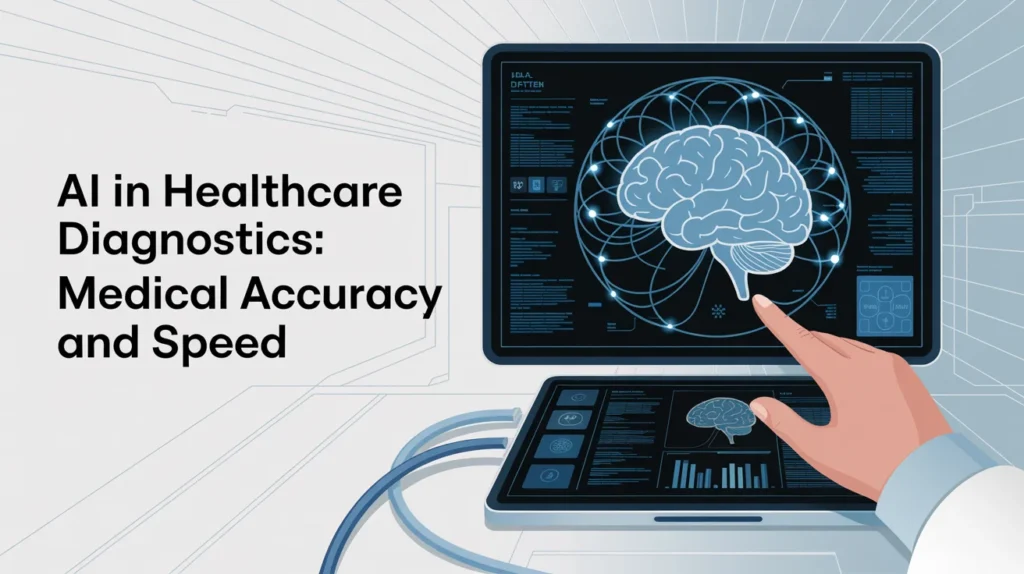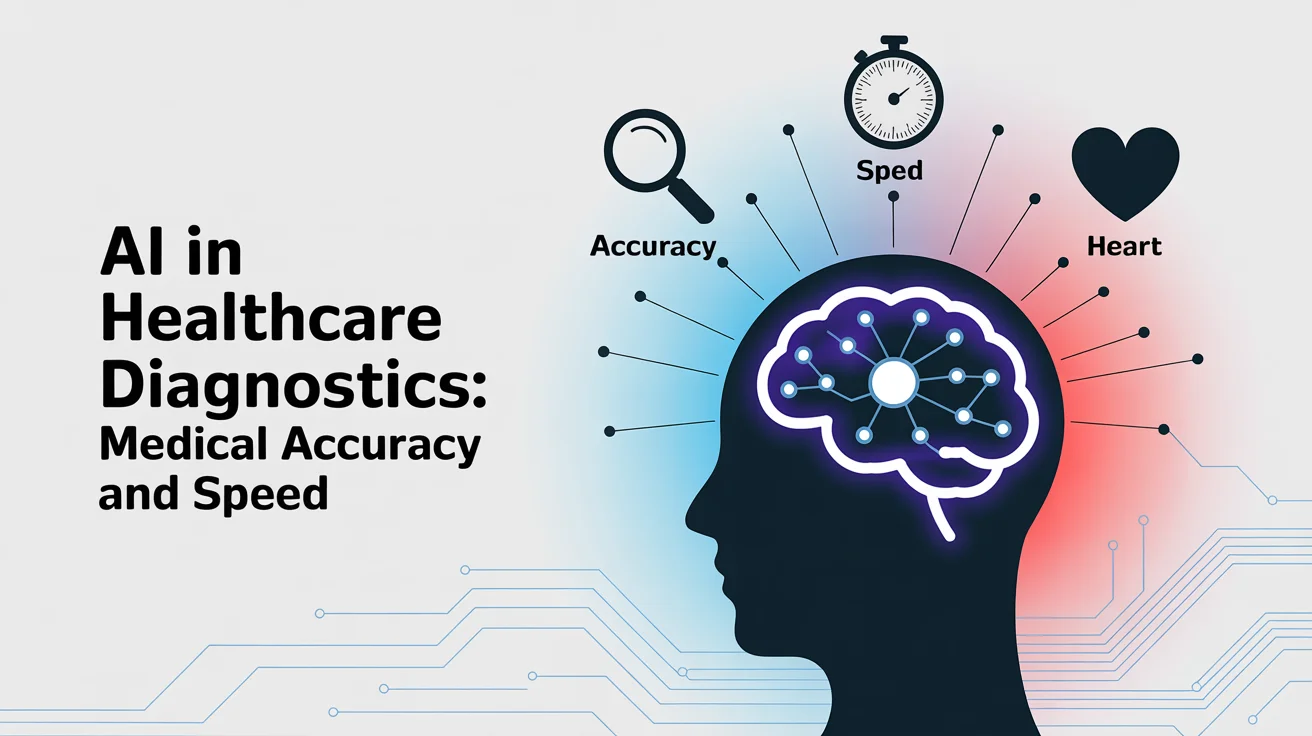Artificial Intelligence (AI) is rapidly transforming healthcare diagnostics. It has introduced a new era where machines assist doctors in detecting diseases faster and more precisely. AI in healthcare diagnostics is no longer a concept of the future; it is actively changing how medical professionals approach patient care today.
Understanding the impact of Artificial Intelligence in Medical Diagnosis is vital for doctors, patients, and healthcare institutions.
This blog explores how AI enhances diagnostic accuracy, reduces errors, and speeds up illness identification. AI tools are reshaping the diagnostic landscape, from image analysis to predictive analytics.
How AI Improves Diagnostic Accuracy
AI technology can analyze complex medical data much faster than humans. It processes medical images, lab results, and patient histories to identify subtle patterns that may go unnoticed. This improves diagnostic accuracy by providing doctors with more reliable information.
By leveraging machine learning algorithms, AI systems can learn from millions of medical records and scans. This experience enables them to recognize diseases at their earliest stages, often crucial for successful treatment.
For example, AI algorithms have successfully detected cancers, heart diseases, and neurological disorders.
Additionally, AI reduces human error by offering second opinions. Sometimes doctors might miss slight anomalies due to fatigue or limited time, but AI systems continuously analyze data with consistent precision.
Speeding Up the Diagnostic Process with AI
One of the biggest challenges in healthcare diagnostics is the time it takes to get results. Traditional diagnostic methods can be slow, delaying treatment. AI drastically shortens this timeframe by automating data analysis.
AI-powered tools can analyze medical images, such as X-rays and MRIs, within seconds. This rapid processing allows doctors to make quicker decisions. Moreover, AI can triage cases by prioritizing urgent scans, ensuring critical patients receive immediate attention.
Faster diagnosis means timely treatment, which can save lives. In emergency situations, AI-driven diagnostics can provide instant insights that can be the difference between life and death.
Key Benefits of AI in Healthcare Diagnostics:
- Increases diagnostic accuracy by recognizing subtle disease patterns
- Reduces human errors caused by fatigue or oversight
- Accelerates analysis of complex medical images and data
- Prioritizes urgent cases for faster medical intervention
- Supports doctors with reliable second opinions
AI-Driven Imaging: Changing the Face of Radiology

Medical imaging is one of the areas most transformed by AI. Radiologists rely heavily on interpreting images to diagnose diseases. AI enhances this by accurately detecting abnormalities such as tumours, fractures, or infections.
Deep learning, a subset of AI, trains systems on thousands of images. This helps the AI understand what normal and abnormal structures look like. As a result, AI can highlight suspicious areas for radiologists to review.
Furthermore, AI reduces radiologists’ workloads by automating routine tasks. This allows specialists to focus more on patient care and complex cases. The combination of human expertise and AI precision improves overall diagnostic quality.
Predictive Analytics: Anticipating Diseases Before Symptoms Appear
AI assists in diagnosis and predicts potential health risks before symptoms develop. Predictive analytics uses patient data such as genetics, lifestyle, and medical history to forecast diseases.
For example, AI models can identify patients at high risk of diabetes or heart disease by analyzing patterns invisible to human eyes. This enables early interventions, preventive care, and personalized treatment plans.
Healthcare providers can use these predictions to allocate resources better and improve patient outcomes. Predictive diagnostics is a proactive approach that shifts healthcare from reaction to prevention.
Challenges and Ethical Considerations in AI Diagnostics
Despite its advantages, Artificial Intelligence in Medical Diagnosis faces several challenges. Data privacy is a significant concern since AI systems require access to sensitive patient information. Ensuring secure data handling and compliance with regulations like HIPAA is crucial.
Moreover, AI models must be trained on diverse and unbiased datasets. Poorly trained AI can produce inaccurate results, leading to misdiagnosis or missed diagnoses. Transparency in AI decision-making is essential so doctors understand how conclusions are drawn.
Another challenge is integrating AI into existing healthcare workflows without disrupting patient care. Training medical staff to work effectively with AI tools is essential.
Addressing AI Challenges in Diagnostics:
- Strict data privacy and security measures
- Use of diverse, representative datasets to avoid bias
- Transparent AI models to explain diagnostic decisions
- Training healthcare professionals on AI technology
- Continuous monitoring and updating of AI systems
The Future of AI in Healthcare Diagnostics: Collaboration Between Humans and Machines
The future of diagnostics lies in collaboration. AI will not replace doctors but will empower them. Machines excel at analyzing data at scale and speed, while humans bring clinical experience and ethical judgment.
This partnership will lead to more accurate, efficient, and personalized diagnostics. Future AI tools will be explainable, meaning they can show why they made a specific decision. This will build trust among medical professionals and patients.
Continuous AI advancements will allow earlier disease detection and improved patient monitoring. Together, human and artificial intelligence can create a healthier world.
What to Expect in AI-Driven Healthcare Diagnostics:
- Enhanced diagnostic precision and speed
- Seamless integration of AI in clinical settings
- Greater focus on personalized and preventive medicine
- Improved patient outcomes through early detection
- Ethical and transparent AI systems with human oversight
Conclusion
AI in healthcare diagnostics is revolutionizing the medical field by making diagnoses faster, more accurate, and less prone to error. It supports doctors by analyzing complex data, predicting risks, and automating routine tasks.
Although challenges like data privacy and bias exist, ongoing improvements promise a future where AI and human expertise work together. This synergy will deliver better healthcare outcomes and transform patient care worldwide.
Frequently Asked Questions:
Q1: Can AI completely replace doctors in diagnostics?
AI assists doctors but cannot replace their judgment and clinical expertise.
Q2: How secure does AI use patient data?
AI systems must follow strict data security and privacy laws to protect sensitive information.
Q3: Does AI diagnosis work for all diseases?
AI is more effective in specific fields like radiology and oncology but continues to expand.
Q4: Is AI in diagnostics expensive?
Costs vary, but AI technology is becoming increasingly affordable and accessible.
Q5: How does AI improve early disease detection?
By analyzing large datasets and recognizing subtle patterns before symptoms appear.




